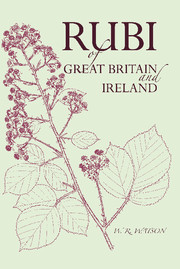Book contents
- Frontmatter
- Foreword
- Preface
- Contents
- INTRODUCTION
- I Environmental variations
- II Genetic intraspecific variations
- III Chromosomes and genes
- IV Reproduction
- V The species in Rubus
- VI Ecesis and migration
- VII Enemies, pests and diseases
- VIII Classification
- IX Collection and identification
- X Characteristics of the British-Irish bramble flora
- XI Cultivating native blackberries for fruit
- XII Note on the nomenclatural type species for the genus Rubus and subgenus Rubus
- XIII Key to the vice-county numbers
- XIV Signs and abbreviations
- ARRANGEMENT OF THE GENUS RUBUS LINN. IN AN ANALYTICAL KEY
- DESCRIPTIONS
- DRAWINGS
- Glossary
- Principal works consulted
- Index
VII - Enemies, pests and diseases
Published online by Cambridge University Press: 05 June 2016
- Frontmatter
- Foreword
- Preface
- Contents
- INTRODUCTION
- I Environmental variations
- II Genetic intraspecific variations
- III Chromosomes and genes
- IV Reproduction
- V The species in Rubus
- VI Ecesis and migration
- VII Enemies, pests and diseases
- VIII Classification
- IX Collection and identification
- X Characteristics of the British-Irish bramble flora
- XI Cultivating native blackberries for fruit
- XII Note on the nomenclatural type species for the genus Rubus and subgenus Rubus
- XIII Key to the vice-county numbers
- XIV Signs and abbreviations
- ARRANGEMENT OF THE GENUS RUBUS LINN. IN AN ANALYTICAL KEY
- DESCRIPTIONS
- DRAWINGS
- Glossary
- Principal works consulted
- Index
Summary
Goats, certainly, and (?) sheep also, when they are tethered up, browse brambles, and I have seen bushes that have been entirely stripped of leaves by them. On the Continent some buprestid larvae are very destructive, and attempts have been made in New Zealand to control their weed RUBI by liberating imported buprestids upon them.
Attacks of the rust fungus, Phragmidium spp., occur on the leaves and stem of brambles, but are not serious. More damaging in Canada is the fungus Hapalosphaeria deformans which destroys the anthers of cultivated blackberries such as R. laciniatus and the Boysenberry and spoils the fruit. For some thirty years past it has been found on R. latifolius in Scotland. The anthers become first granulated and then powdered with the white spores.
A virus is probably the cause of arrested, tufted, dwarf growth, in which the deformed panicles do not flower and the plant dies off in a few years. I can find no fungus on such bushes.
The most prevalent and most troublesome disease, however, found upon brambles is the felt-disease, which is believed to be a kind of gall due to a mite-attack. An extremely dense coating of brassy coloured felt extends over branches, leaves, pedicels, calyces and fruit; it masks or replaces the true felt or hair covering and inhibits the production of glands and acicles. The disease seriously checks the growth of the bramble and gives it a very sickly look. Some parts of the plant may be found to be less attacked than others, but it is better not to collect from such bushes at all. Rooted tips carry the infection, but if a ripe or nearly ripe fruit can be found and the seeds are cleaned thoroughly before sowing, clean seedlings can be obtained.
- Type
- Chapter
- Information
- Publisher: Cambridge University PressPrint publication year: 2013



